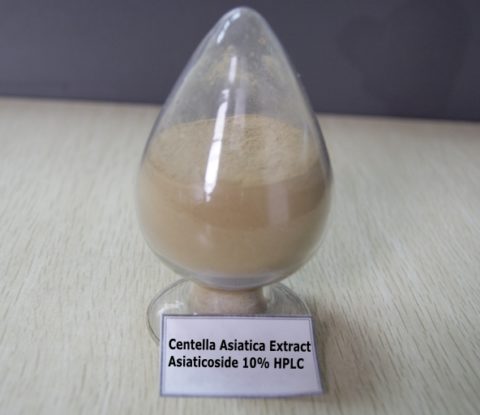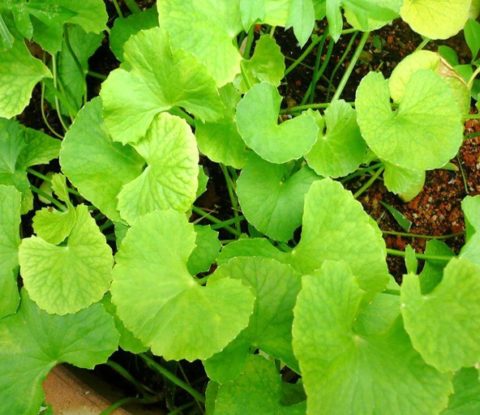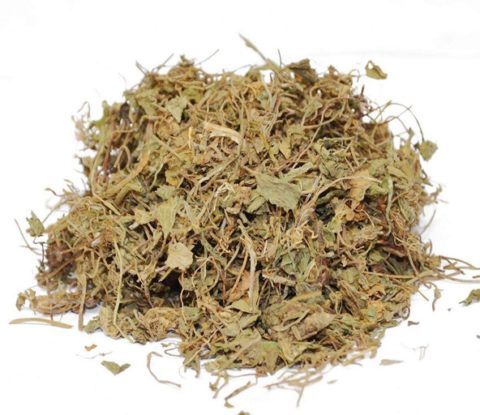
Centella Asiatica Extract
【Family】: Umbelliferae
【Genera】: Centella
【Latin Name】: Centella asiatica(L.)Urba
【Specifications】: Total Asiaticosides 10%-80% HPLC; Asiaticoside 10%,30%,40%,90% HPLC, 10:1, 20:1 TLC
【Appearance】: Yellowish brown powder to white fine powder
【CAS NO.】: 16830-15-2
【Active Ingredient】: Asiaticoside
【Molecular Formula】: C48H78O1
【Molecular Weight】: 959.12
【Soluble Ability】: None soluble in water, soluble in alcohol and pyridine
【Part used】: The whole plant of Centella asiatic
【Application】: Cosmetics or health-care products
Brief Introduction
Centella asiatica grows in tropical swampy areas.The stems are slender, creeping stolons, green to reddish-green in color, connecting plants to each other. It has long-stalked, green, reniform leaves with rounded apices which have smooth texture with palmately netted veins. The leaves are borne on pericladial petioles, around 2 cm. The rootstock consists of rhizomes, growing vertically down. They are creamish in color and covered with root hairs.
The flowers are pinkish to red in color, born in small, rounded bunches near the surface of the soil. Each flower is partly enclosed in two green bracts. The hermaphrodite flowers are minute in size, with 5-6 corolla lobes per flower. Each flower bears five stamens and two styles. The fruit are densely reticulate, distinguishing it from species of Hydrocotyle which have smooth, ribbed or warty fruit.The crop matures in three months, and the whole plant, including the roots, is harvested manually.
Its active constituents are pentacyclic triterpenoids which have regulating and activating functions, acting on the collagen present in many organs. In skin, the major components are collagens type I and II. Skin aging is related mainly to a decrease in type I collagen levels, which also plays a major role in wound healing. Studies have shown that the main constituents of Centella asiatica (Asiatic acid, madecassic acid, and asiaticoside) increase collagen synthesis. In addition to stimulating the synthesis of collagen, it also improves tensile strength of the skin.
Benefits of Centella Asiatica Extract
Centella asiatica in cosmetic applications
Centella asiatica is a popular addition to many skin creams and therapies. Extract of centella can be found in body slimming tonics, body-firming products, and anti-aging products. For decades, this herb has proven itself to be miraculous in terms of scar and wound healing. Doctors have used it to help women both before and after pregnancy. It can be used to discourage varicose veins and stretch marks, and then again after birth for healing. One reason centella has been found to be so restorative is because it is said to promote an increase of hemoglobin. The reparative effects improve the venal system and encourage positive connective tissue growth.
The proven clinical efficacy of Centella asiatica selected triterpenes has led to its incorporation in numerous cosmetic products including soothing creams and milks, repairing and regenerating creams, after-sun creams, after-shave products, creams for chapped hands and cellulite.
Development and metabolism of connective tissue:
The active ingredients of the selected triterpenes of Centella asiatica have shown to have modulating properties on the development and metabolism of connective tissue. This activity is mediated by the effect on fibroblasts and on two aminoacids relevant for the collagen metabolism: alanine and proline. Consequently the selected triterpenes of Centella asiatica may help improve wound repair with a better re-epithelialisation and a normalization of perivascular connective tissue allowing an improvement of the venous wall tone and elasticity.
Increase in collagen:
Although studies show that the selected triterpenes of Centella asiatica does not affect cell proliferation, total protein synthesis and biosynthesis of proteoglycans, a significant increase in the percentage of collagen and in cell layer fibronectin were observed explaining its action in promoting wound healing.
Keratinisation:
The selected triterpenes of Centella asiatica may also affect various stages of tissue development including keratinisation (the process of replacing skin after sores or ulcers) and stimulate the formation of lipids and proteins necessary for healthy skin and are also reported to be capable of fixing alanine and proline into the structure of collagen, and so help promote healing in the care of epithelial ulcers, bedsores and skin disorders. Centella asiatica has also been shown to increase the levels of enzymatic and non-enzymatic antioxidants such as superoxide dismutase, catalase, glutathione peroxidase, vitamin E and ascorbic acid in newly formed tissues.”
Wound Healing
Wound healing benefits of Centella asiatica extract were demonstrated in a study published in the October 2012 issue of the journal “Phytomedicine.” In the tissue culture study of human skin cells, asiaticoside increased migration and adhesion of new skin cells to the wound site. Asiaticoside also increased the numbers of skin-producing cells. Researchers note that asiaticoside may be useful as a component of artificial skin during wound healing.
Brain Benefits
Centella asiatica may help protect the brain from damage due to toxic metal exposure, according to a study published in the December 2012 issue of the journal “Neurological Sciences.” In the animal study, daily doses of 150 or 300 milligrams per kilogram body weight for six weeks decreased oxidative stress — the damaging effects of toxins and cellular waste products — caused by aluminum. The herb also improved memory and decreased aluminum levels. Researchers concluded that Centella asiatica shows potential as a natural supplement for protecting against cognitive dysfunction and other forms of nerve damage from exposure to aluminum.
Cancer Prevention
A study published in the December 2012 issue of the “International Journal of Molecular Medicine” found that Centella asiatica may help protect against skin cancer caused by exposure to ultraviolet radiation. Treatment of human skin cells with Centella asiatica decreased the toxic effects of ultraviolet radiation by modulating the activity of certain genetic components of the cells.
Liver Health
Asiaticoside, an extract of Centella asiatica, may help prevent liver injury, according to an animal study published in the August 2010 issue of the journal “Phytomedicine.” Doses of 5, 10 or 20 milligrams per kilogram body weight of asiaticoside daily for three days reduced elevated liver enzymes in response to a liver-toxic chemical. Asiaticoside also decreased tissue destruction and significantly improved liver function.
Antianxiety
Centella asiatica decreased anxiety in laboratory animals in a study published in the September 2012 issue of the “Journal of Ethnopharmacology.” In the study, researchers observed significant improvements in several stress-induced behaviors in Centella asiatica-supplemented animals. The herb also improved body weight and levels of stress hormones. These preliminary results suggest that Centella asiatica may be a useful, natural means for managing chronic stress.






